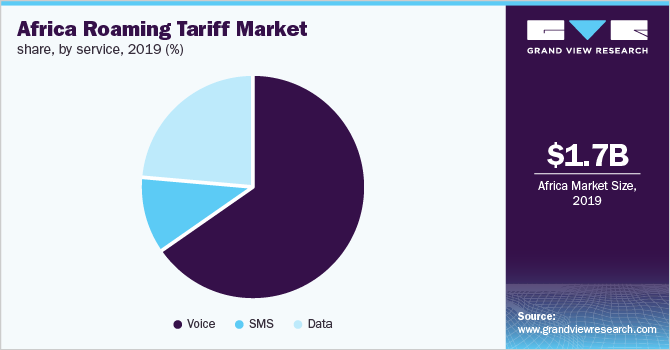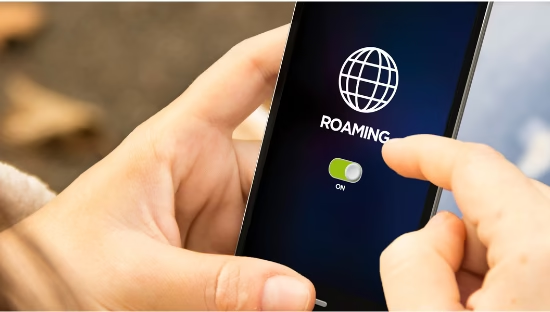
Africa roaming tariff market forecasts, 2020 – 2027
The Africa roaming tariff market size was valued at USD 1.7 billion in 2019 and is expected to register a CAGR of 5.5% from 2020 to 2027. The roaming tariff is the charge incurred by the communication service providers by allowing the customers to access their communication devices outside the geographical coverage of the network.
Roaming tariffs vary nationally and internationally. The growing adoption of smartphones and the internet has had a positive impact on the market. Moreover, the increasing number of international travelers is expected to increase the demand for roaming tariffs in Africa. Similarly, roaming tariffs implied on services such as voice, data, and SMS are different, Grand View Research reports.
The market for roaming tariffs in Africa is expected to witness significant growth over the forecast period owing to an increasing mobile subscriber base coupled with rising internet penetration. The number of smartphone users in Africa is growing at a substantial rate. For instance, according to the GSM Association, the number of SIM connections was 774 million and is expected to reach up to 1.0 billion by the end of 2025 in Africa. Owing to the above-mentioned facts, technological awareness in rising among the consumer base across the region.
Sub-Saharan Africa is expected to make a major contribution to market growth owing to increasing mobile subscriptions in this region. According to the GSMA association, by 2025, 50.0% of the total population is projected to subscribe to mobile services. Countries such as Nigeria, Ethiopia, the Democratic Republic of the Congo (DRC), Tanzania, and Kenya will contribute to the growing penetration rate of the mobile subscriber base. GSMA also states that subscriber penetration of the Economic Community of West African States (ECOWAS) and the Southern African Development Community (SADC) will increase from 48.0%, and 44% in 2018 to 54%, and 50% respectively, by 2025.
The Mobile Network Operators (MNO) and network providers are indulged in making investments in the region. Various initiatives are introduced by the regulatory authorities and the MNO/network operators to expand the existing customer base. For instance, the KaiOS’smart feature phone’ initiative is projected to give impetus to smartphone adoption. The KaiOS initiative is led by some of the leading operators in the region, such as Vodafone Group, and AT&T Inc., is expected to boost smartphone adoption in the area.
Moreover, the launch of the One Network Area (ONA) roaming initiative in East Africa intends to reduce the high tariff associated with mobile roaming to promote regional integration. The ONA is based on specific regulatory norms, one of which is, the elimination of roaming tariffs on receiving calls in Rwanda, Kenya, Uganda, and South Sudan if the call originates in one of the mentioned countries. Similar regulatory initiatives are emerging in other parts of Africa, which are expected to drive the market for roaming tariffs in Africa from 2020 to 2027.
Type Insights
The national roaming segment is anticipated to dominate the market over the forecast period owing to demographic bulge. Increasing use of smartphones and the internet by young consumers in a region is anticipated to propel the national roaming segment in that region. The international roaming segment is expected to witness the highest CAGR of 5.0% over the forecast period owing to rising international tourism.
Distribution Channel Insights
Based on the distribution channel, the Africa roaming tariff market is segregated into retail roaming and wholesale roaming. Based on the application or usage, the distribution channel of the roaming services is decided. Individual users account for retail roaming, whereas the services purchased in bulk come under wholesale roaming. The enterprises mainly use wholesale roaming as the requirements are large in number. Although the retail tariff rates are more expensive than the wholesale channel, thereby, the share of the wholesale channels exceeds 90.0% share of the distribution channel. This is attributed to the extensive customer base of the wholesale channel as compared to the retail channel.
The retail roaming channel is expected to witness a CAGR of 6.0% over the forecast period. The ONA initiative demands MNO’s renegotiate with their roaming partners to reduce tariffs and offer cheaper services to their customers. Moreover, the implementation of the wholesale channel has many regulatory limitations due to the involvement of a larger customer base. For instance, as per the call termination regulation in South Africa, published in September 2014, wholesale interconnection tariffs are charged between fixed and mobile network operators. Hence, it gives less flexibility for the operators to vary their tariffs, which is not the case in the retail channel.
Service Insights for Africa roaming forecasts
Based on services, the market roaming tariff in Africa is categorized into voice, SMS, and data. The data service type is expected to exhibit the highest CAGR of over 6.0%. The increasing adoption of smartphones in the region is expected to cater to the significant growth of the data roaming service. As per the GSM Association, the subscriber base of mobile internet usage is expected to reach up to 483.0 million in 2025 from 239.0 million in 2018, which, in turn, augments the usage of data roaming in the region.
However, the voice service segment holds the major share of the service segment of over 60.0% as compared to SMS and data. Voice is the preferred communication medium among customers, as conveying information is easier. The other service types, such as SMS and Data, are more prone to intrusions, and 100% safe communication is not assured. Voice communication is feasible for both literate as well as illiterate people. The above-mentioned factors lead to high adoption of voice service rather than any other service type.
Regional Insights
Sub-Saharan Africa accounts for the significant revenue share generated by the market for roaming tariffs in Africa. Increasing operator revenue from USD 42.0 billion to USD 51.0 billion will account for the growth of the market for roaming tariffs in Africa. Various investments and initiatives, such as ONA and KaiOS, are projected to have a positive impact on market growth. For instance, in September 2016, Bharti Airtel Ltd. launched a new International Roaming (IR) pack that provides free incoming calls and texts to India on international roaming. The above-mentioned development of the company enabled Bharti Airtel Ltd. to increase its customer base by attracting international traveler subscriptions. Moreover, the presence of all the major players, such as Vodafone Group and AT&T Inc., in the market in sub-Saharan Africa has also led to significant market growth in the region.
Africa Roaming Tariff Market Share Insights
Major players operating in the market for roaming tariff in Africa include America Movil; AT&T Inc.; Bharti Airtel Ltd.; China Mobile Ltd.; Deutsche Telekom AG; Digicel Group; Sprint Corporation; Telefonica SA; Verizon Communications Inc.; and Vodafone Group plc. The market for roaming tariffs in Africa is moderately consolidated due to abundant growth opportunities in the region. Therefore, all established players are trying to sustain their market position. The above-mentioned players are involved in launching new service lines at competitive prices. Additionally, the key players are entering into mergers and acquisitions/strategic partnerships. For instance, in January 2019, Verizon Communications Inc. acquired Protect Wise Inc. to expand its network detection and response concerning security threats. This step was taken to serve the growing 5G market. Similarly, in October 2018, the wholesale business unit of Telefonica SA, Telefonica International Wholesale Services, announced the launch of a data roaming monitoring solution. Through this initiative, the company is expected to expand the range of its international connectivity services.











